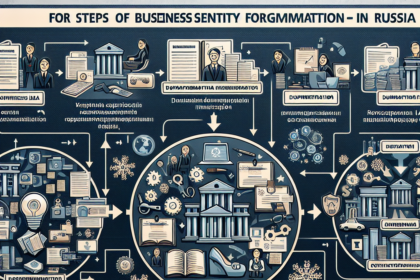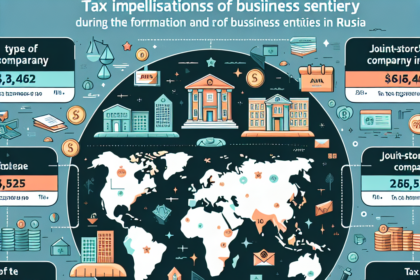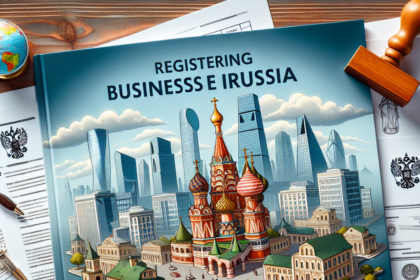Tag: Formation and Registration of Business Entities in Russia
Introduction
Starting a business in Russia involves navigating a detailed legal and bureaucratic landscape. This comprehensive guide provides an in-depth look at the formation and registration of business entities in Russia, covering various types of entities, legal requirements, registration procedures, and the benefits of each entity type. Understanding these aspects is crucial for entrepreneurs and businesses aiming to establish a foothold in the Russian market.
Chapter 1: Types of Business Entities in Russia
1.1 Sole Proprietorship (Individual Entrepreneur)
Overview
A sole proprietorship, or individual entrepreneur (Индивидуальный предприниматель, IP), is a business owned and operated by a single individual.
Legal Requirements
- Registration: Registration with the local tax authority (Федеральная налоговая служба, FNS).
- Licenses and Permits: Specific business activities may require additional licenses or permits.
- Tax Identification Number (INN): Must obtain an INN from the tax authority.
Advantages
- Ease of Formation: Simple and cost-effective to set up.
- Full Control: Owner has complete control over business decisions.
- Simplified Accounting: Less complex accounting and reporting requirements.
Disadvantages
- Unlimited Liability: Owner’s personal assets are at risk.
- Limited Capital: Difficulty in raising large amounts of capital.
- Limited Life: Business does not survive the owner’s death or incapacitation.
1.2 Partnership
General Partnership
Overview
A general partnership (Полное товарищество) involves two or more individuals sharing ownership and management responsibilities.
Legal Requirements
- Partnership Agreement: Strongly recommended to outline partners’ roles and profit-sharing.
- Registration: Must register with the local tax authority.
- Licenses and Permits: Depending on business activities, additional licenses may be needed.
Advantages
- Shared Resources: Combines resources and expertise of multiple partners.
- Tax Benefits: Pass-through taxation, where income is reported on partners’ personal tax returns.
Disadvantages
- Unlimited Liability: Each partner is personally liable for the business’s debts.
- Potential for Disputes: Risk of conflicts between partners.
Limited Partnership
Overview
A limited partnership (Коммандитное товарищество) includes both general and limited partners.
Legal Requirements
- Partnership Agreement: Must clearly define the roles of general and limited partners.
- Registration: Required with the local tax authority.
- Licenses and Permits: May be required based on business activities.
Advantages
- Limited Liability for Limited Partners: Limited partners’ liability is restricted to their investment.
- Attracts Investors: Easier to raise capital by attracting limited partners.
Disadvantages
- Complex Formation: More legal formalities than a general partnership.
- Limited Control for Limited Partners: Limited partners cannot participate in management without risking their limited liability status.
1.3 Limited Liability Company (LLC)
Overview
A Limited Liability Company (Общество с ограниченной ответственностью, OOO) is a popular business entity due to its flexibility and limited liability protection.
Legal Requirements
- Charter: Must draft and file the company charter with the local tax authority.
- Founders’ Agreement: May be required, detailing the roles and responsibilities of the founders.
- State Registration: Register with the local tax authority.
- Licenses and Permits: Required depending on business activities.
- Share Capital: Minimum share capital requirement of RUB 10,000.
Advantages
- Limited Liability: Owners’ personal assets are protected.
- Flexibility: Flexible management structure.
- No Restrictions on Ownership: No limit on the number of owners.
Disadvantages
- Formation Complexity: More paperwork and legal formalities compared to sole proprietorships.
- Cost: Higher setup and maintenance costs.
1.4 Joint-Stock Company (JSC)
Public Joint-Stock Company (PJSC)
Overview
A Public Joint-Stock Company (Публичное акционерное общество, PAO) is suitable for large businesses looking to raise capital through public offerings.
Legal Requirements
- Charter: Must draft and file the company charter.
- State Registration: Register with the local tax authority.
- Securities Registration: Register issued shares with the Central Bank of Russia.
- Share Capital: Minimum share capital requirement of RUB 100,000.
Advantages
- Raising Capital: Can raise significant capital through public offerings.
- Limited Liability: Shareholders’ liability is limited to their investment.
- Perpetual Existence: Continues to exist beyond the shareholders’ involvement.
Disadvantages
- Complexity and Cost: Complex formation and high setup costs.
- Regulation and Disclosure: Subject to stringent regulatory and disclosure requirements.
Private Joint-Stock Company (PJSC)
Overview
A Private Joint-Stock Company (Непубличное акционерное общество, OAO) is similar to a public JSC but does not offer shares to the public.
Legal Requirements
- Charter: Must draft and file the company charter.
- State Registration: Register with the local tax authority.
- Securities Registration: Register issued shares with the Central Bank of Russia.
- Share Capital: Minimum share capital requirement of RUB 10,000.
Advantages
- Limited Liability: Shareholders’ liability is limited to their investment.
- Raising Capital: Easier to attract private investors.
Disadvantages
- Complexity and Cost: Complex formation and higher costs.
- Limited Liquidity: Shares are not publicly traded.
Chapter 2: Legal Requirements for Business Formation
2.1 Choosing a Business Name
Naming Guidelines
- Uniqueness: The business name must be unique and not infringe on existing trademarks.
- Compliance: Must comply with local naming regulations, avoiding restricted or offensive terms.
- Language: Generally required to be in Russian.
Registration
- Name Reservation: Optional, but can secure the name prior to registration.
- Approval: Obtain approval from the local tax authority during the registration process.
2.2 Drafting Foundational Documents
Charter (Устав)
- Content: Includes company name, legal address, activities, share capital, management structure, and rights and obligations of shareholders.
- Filing: Must be filed with the local tax authority.
Founders’ Agreement
- Content: Details the roles, responsibilities, and contributions of the founders.
- Filing: Not always required, but recommended for clarity and dispute resolution.
2.3 Registration Process
Federal Tax Service (FNS)
- Application Submission: Submit the registration application to the local office of the Federal Tax Service.
- Required Documents: Includes the charter, founders’ agreement, proof of share capital, and identification documents.
- Registration Fee: Pay the required registration fee.
State Registration Number (OGRN)
- Issuance: Upon successful registration, the Federal Tax Service issues a State Registration Number (OGRN).
- Certificate of Registration: Provides legal status to the business entity.
2.4 Licenses and Permits
Business Activities
- Specific Licenses: Certain business activities require additional licenses or permits (e.g., alcohol sales, pharmaceuticals, financial services).
- Regulatory Authorities: Different activities are regulated by specific government agencies (e.g., Ministry of Health, Central Bank of Russia).
Application Process
- Documentation: Submit required documentation to the relevant authority.
- Inspections: Some licenses may require inspections of premises or compliance checks.
Chapter 3: Taxation and Compliance
3.1 Tax Identification Number (INN)
Overview
- Requirement: All business entities must obtain a Tax Identification Number (INN) from the Federal Tax Service.
Application Process
- Form Submission: Submit an application form along with registration documents.
- Issuance: Receive the INN upon successful registration.
3.2 Tax Regimes
General Tax System
- Applicability: Default tax regime for businesses.
- Taxes: Includes corporate income tax, value-added tax (VAT), and other applicable taxes.
Simplified Tax System (STS)
- Eligibility: Small businesses meeting specific criteria (e.g., revenue limits, number of employees).
- Taxes: Simplified tax reporting and lower tax rates.
3.3 Corporate Income Tax
Rates
- Standard Rate: 20% on corporate profits.
- Special Rates: Vary for certain activities or regions.
Calculation
- Taxable Income: Calculated based on revenue minus allowable expenses.
- Deductions: Includes business expenses, depreciation, and other deductions.
3.4 Value-Added Tax (VAT)
Rates
- Standard Rate: 20% on most goods and services.
- Reduced Rates: 10% for certain essential goods (e.g., food, pharmaceuticals).
Compliance
- Registration: Mandatory for businesses exceeding a revenue threshold.
- Reporting: Regular VAT filings and payments.
3.5 Social Security Contributions
Overview
- Contributions: Employers must make social security contributions for employees.
- Rates: Vary based on employee income and social security programs.
Compliance
- Reporting: Regular reporting and payment of contributions to the relevant authorities.
Chapter 4: Employment Law and Labor Relations
4.1 Employment Contracts
Requirements
- Written Contract: Mandatory for all employees.
- Content: Must include job description, salary, working hours, and other terms.
Types of Contracts
- Permanent Contracts: Indefinite duration with standard employment terms.
- Fixed-Term Contracts: Specific duration for temporary or project-based employment.
4.2 Employee Rights and Protections
Minimum Wage
- Requirement: Employers must comply with the national minimum wage laws.
Working Hours
- Standard Hours: 40 hours per week.
- Overtime: Compensation for hours worked beyond the standard workweek.
Leave Entitlements
- Annual Leave: Paid leave entitlement based on length of service.
- Sick Leave: Paid leave for illness or medical treatment.
- Maternity Leave: Paid leave for expectant and new mothers.
4.3 Termination of Employment
Grounds for Termination
- Performance: Poor performance or misconduct.
- Redundancy: Business restructuring or economic reasons.
- Mutual Agreement: Both parties agree to terminate the contract.
Notice Period
- Requirement: Employers must provide a notice period, typically 2 weeks to 2 months, depending on the reason for termination.
Severance Pay
- Eligibility: Certain terminations require severance pay, such as redundancy or termination without cause.
Chapter 5: Intellectual Property Protection
5.1 Trademarks
Registration
- Authority: Federal Service for Intellectual Property (Rospatent).
- Application: Submit an application with a description of the mark and the goods/services it will represent.
Protection
- Duration: Initial protection for 10 years, renewable indefinitely.
- Enforcement: Legal action against infringement.
5.2 Patents
Types of Patents
- Utility Patents: For new and useful inventions or discoveries.
- Design Patents: For new, original, and ornamental designs.
- Plant Patents: For new and distinct plant varieties.
Application Process
- Authority: Federal Service for Intellectual Property (Rospatent).
- Requirements: Detailed description and claims of the invention.
5.3 Copyrights
Protected Works
- Scope: Literary, artistic, musical works, and software.
Registration
- Optional: Automatic protection upon creation, but registration provides legal advantages.
5.4 Trade Secrets
Protection Measures
- Confidentiality Agreements: Legal agreements to protect sensitive information.
- Internal Policies: Implementing security measures within the company.
Chapter 6: Special Economic Zones and Incentives
6.1 Overview
Purpose
- Attraction: Designed to attract foreign investment and promote economic development.
6.2 Types of Special Economic Zones
Free Economic Zones (FEZ)
- Benefits: Tax incentives, simplified customs procedures, and reduced administrative burdens.
Technology and Innovation Zones
- Focus: Support for high-tech industries and innovative businesses.
- Incentives: Grants, tax benefits, and research and development support.
6.3 Incentives for Foreign Investors
Tax Incentives
- Reductions: Reduced corporate income tax rates.
- Exemptions: Exemptions from certain local taxes.
Grants and Subsidies
- Availability: Financial support for specific projects or industries.
6.4 Application Process
Eligibility
- Criteria: Meeting specific investment and business activity requirements.
- Application: Submitting detailed business plans and financial projections.
Chapter 7: Business Operations and Compliance
7.1 Accounting and Reporting
Financial Statements
- Requirements: Preparation of balance sheets, income statements, and cash flow statements.
Auditing
- Mandatory Audits: Required for larger businesses or those in certain industries.
7.2 Annual Reports
Submission
- Authority: Federal Tax Service.
- Content: Financial performance, management analysis, and corporate governance information.
7.3 Corporate Governance
Board of Directors
- Responsibilities: Oversight of management and strategic direction.
Shareholder Meetings
- Frequency: Annual general meetings to discuss business performance and make key decisions.
7.4 Compliance with Regulations
Industry Regulations
- Specific Requirements: Compliance with industry-specific laws and regulations.
Environmental and Health Regulations
- Standards: Adherence to environmental protection and workplace safety standards.
Conclusion
The formation and registration of business entities in Russia involve navigating a complex legal and bureaucratic landscape. This comprehensive guide covers the various types of business entities, legal requirements, registration procedures, and benefits, providing a valuable resource for entrepreneurs and businesses aiming to establish operations in Russia. By understanding these aspects, businesses can make informed decisions, ensuring compliance with Russian laws and optimizing their chances for success in the Russian market.
FAQs
- What are the main types of business entities in Russia?
- The main types include sole proprietorships, general and limited partnerships, limited liability companies (LLCs), and joint-stock companies (JSCs).
- What is the minimum share capital requirement for an LLC in Russia?
- The minimum share capital requirement for an LLC in Russia is RUB 10,000.
- What are the benefits of forming a business in a Special Economic Zone in Russia?
- Benefits include tax incentives, simplified customs procedures, and reduced administrative burdens.
- How is corporate income tax calculated in Russia?
- Corporate income tax is calculated based on revenue minus allowable expenses, with a standard rate of 20%.
- What are the key documents required for registering a business in Russia?
- Key documents include the company charter, founders’ agreement, proof of share capital, and identification documents.
By understanding these aspects of business formation and registration in Russia, individuals and businesses can better navigate the legal landscape and ensure they operate within the bounds of the law.











